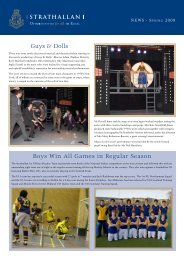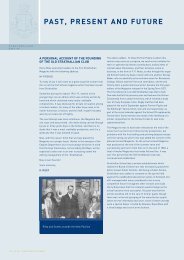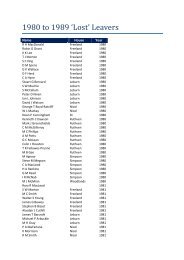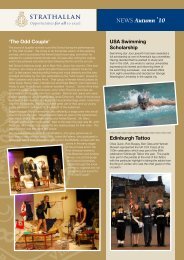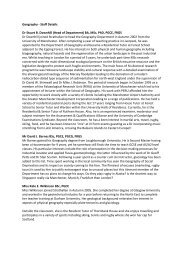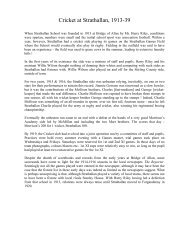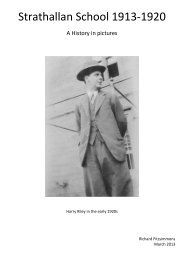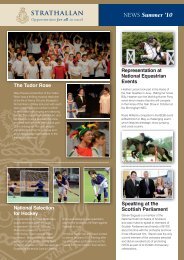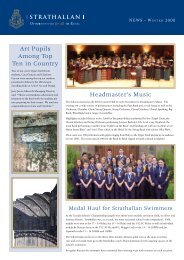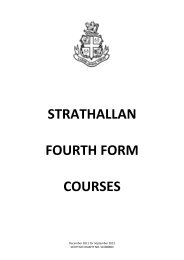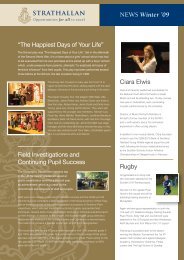Strathallan Resurgent, 1920-30 - Strathallan School
Strathallan Resurgent, 1920-30 - Strathallan School
Strathallan Resurgent, 1920-30 - Strathallan School
Create successful ePaper yourself
Turn your PDF publications into a flip-book with our unique Google optimized e-Paper software.
<strong>Strathallan</strong> <strong>Resurgent</strong>, <strong>1920</strong>-<strong>30</strong><br />
It is tempting for present-day generations<br />
of Strathallians to think that the immense<br />
investments of the last twenty years,<br />
essentially six new boarding houses and a<br />
sumptuous extension for Riley House,<br />
together with a new state of the art medical<br />
centre, not to mention a palatial art centre,<br />
comprise the biggest period of expansion<br />
in the <strong>School</strong>’s history. True, numbers in<br />
this period almost doubled under the<br />
stewardship of David Pighills (1975-1993),<br />
necessitating the programme which placed<br />
<strong>Strathallan</strong> in the forefront of Independent<br />
education. But the first 20 years of<br />
<strong>Strathallan</strong>’s existence in Forgandenny saw<br />
developments which were just as<br />
impressive and which were the envy of<br />
many other public schools of the time.<br />
Grounds of 60 acres and the main house –<br />
Freeland – were purchased from Edward Martin<br />
Stewart for £10,000.<br />
Let us remember that when he came to<br />
Forgandenny in <strong>1920</strong>, Harry Riley had few<br />
capital assets and had had to borrow a very<br />
substantial amount to buy Freeland<br />
mansion and its immediate policies,<br />
comprising sixty acres of gardens and open<br />
fields in addition to the mostly wooded<br />
areas around the main house. He came to<br />
Forgandenny with 120 boys and 6 masters,<br />
a risky financial venture in the depressed<br />
aftermath of the Great War, but quickly set<br />
about turning the estate and its buildings<br />
into a school. The mansion house soon<br />
became dormitories for the boys and rooms<br />
for Headmaster and the masters, the main<br />
classrooms were fashioned out of the<br />
former estate stables in what is now the<br />
Riley courtyard, whilst the sciences were<br />
taught in the old greenhouses adjacent to<br />
the vegetable garden in the space now<br />
occupied by the Chemistry and Biology<br />
departments.<br />
A Physics Laboratory in the <strong>1920</strong>s – a converted<br />
garden shed.<br />
It is difficult to imagine now the sort of<br />
sacrifices that the Founder had to make in<br />
order to realise his dream of making<br />
<strong>Strathallan</strong> one of the pre-eminent schools<br />
in Scotland but David Bogie, later to be a<br />
major Old Strathallian figure in the future<br />
success of the <strong>School</strong>, had this to say,<br />
‘Harry Riley continued to live simply and<br />
without any material luxuries. He ploughed<br />
back every penny of profit into the school.<br />
It would be true to say that at each summer<br />
vacation some capital asset would be<br />
created and ready for use in September.’<br />
Developments continued apace in the<br />
<strong>1920</strong>s with the appointment of R. N. Bain<br />
as estate foreman in 1923. Indeed, Mr.<br />
Bain was to be associated with every new<br />
building and project until his retirement in<br />
1956. One of his first responsibilities was<br />
to complete the construction of the new<br />
gymnasium, quickly followed by making<br />
the rest of the classrooms respectable and<br />
beginning the conversion of the old<br />
coachhouse into the sanatorium (now the<br />
older part of Riley House). In 1924 the<br />
Lawn and Paddock were levelled and<br />
cricket squares laid for both practice and<br />
match play. During the process of levelling
the Paddock a grave was discovered,<br />
probably of medieval origin, though it was<br />
believed in 1924 to have been that of a<br />
Roman soldier. Harry Riley’s reaction was<br />
to say, ‘Let the poor fellow lie’, so the<br />
stones were replaced and the ground<br />
slightly raised.<br />
1 st XV pitch – now Mudflats<br />
The gymnasium was opened at the end of<br />
1923 and those Old Strathallians who can<br />
still remember the school races and trials<br />
in the Earn may also recall the opening of<br />
the swimming pool in 1928, one of the first<br />
in a Scottish school.<br />
Riley Paddock in the <strong>1920</strong>s<br />
When the school had transferred to<br />
Forgandenny in <strong>1920</strong> there were no<br />
sporting facilities other than for tennis,<br />
croquet and archery, so a lot had to be<br />
done between the purchase and the<br />
opening of the <strong>School</strong>.<br />
The gym in 1923<br />
The Lawn cricket ground, some time before 1926<br />
One of the greatest problems at Bridge of<br />
Allan had been the provision of sleeping<br />
accommodation. At Forgandenny this was<br />
not such a problem in the early years,<br />
though by 1927 with school numbers on<br />
the increase, it was decided to build a new<br />
boarding house annexe, attached to the<br />
main school building.<br />
The main lawn to the south of the House<br />
was made into a cricket ground, although it<br />
was smaller than it is today - the area now<br />
occupied by the music practice rooms was<br />
once an ornate rose garden. The First XV<br />
pitch in these days was situated on what<br />
we now know as Mudflats pitch 2, flanked<br />
by a stand on the northern side.<br />
A typical <strong>1920</strong>s dorm
The purpose was to be able to split the<br />
school into four boys houses and, in<br />
addition, provide a central dining area for<br />
the whole community. Thus was Simpson<br />
House born, named for Riley’s mother’s<br />
family, conceived and completed by 1929.<br />
At the same time a reorganisation of the<br />
Chapel took place to fit everyone in and<br />
the first formal school library was proof of<br />
growing excellence in <strong>Strathallan</strong>’s<br />
examination results.<br />
Simpson House, ca. 1929. The House was named<br />
after Harry Riley’s mother’s Rose Mary Simpson.<br />
The first House Captain was Stuart Ferguson.<br />
One might expect that, after a period of<br />
such expansion and improvement, a few<br />
years of retrenchment and planning might<br />
have taken place, but Harry Riley was not<br />
one to rest on his laurels and both staff and<br />
pupils were to be kept in anticipation for<br />
what each new September might bring<br />
with respect to building projects. At this<br />
point it might be well to note also that each<br />
new development seems to have been<br />
financed out of school surplus income and<br />
that borrowing was kept to a minimum.<br />
With the end of the <strong>1920</strong>s came the Great<br />
Depression caused by the collapse of the<br />
American stock market, a period when<br />
many schools suffered decline and<br />
eventual closure. That <strong>Strathallan</strong> survived<br />
and continued to prosper says much about<br />
the financial acumen of Harry Riley and<br />
his advisers, John Maitland Cowan and<br />
David Bogie, together with the Strathallian<br />
Club which, in the next decade, was to<br />
prove essential to the future well-being of<br />
the <strong>School</strong>.<br />
The Beech Avenue, sadly torn down in the 1960s<br />
to make room for the present Chapel.<br />
The main entrance in the <strong>1920</strong>s<br />
Looking from the main entrance over the present<br />
Chapel lawn.




